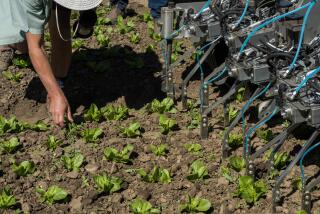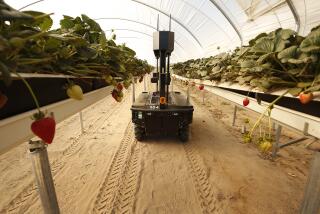High-Tech Farms Seen as Way to Reap Profit
- Share via
To survive, farmers of the future will have to understand and apply sophisticated biotechnology and computer techniques, many of which are only vaguely conceived yet, a university professor says.
“The 20-year period in front of us will see major introductions in both biotechnology and computers,” Robert Kalter, agricultural economics professor at Cornell University, said at a California Agribusiness Management Seminar in Fresno.
“People who are able to understand those technologies, see the way to make them useful in their operations and adopt them successfully are going to be the winners,” Kalter said. “Those people who are not able to see the value of new technology, not able to understand or finance it are going to be losers in this game.”
In the area of computers, Kalter said, there will be wider use of personal computers to link farmers to their markets, to provide artificial intelligence to help manage the farm by making tactical decisions and to control the environment in animal barns.
Robotics also will be used on farms, he predicted. Kalter said two companies already are “looking at ways to use robots to replace milkers.”
Kalter touched on several likely developments in biotechnology, which he defined as manipulation of biological agents by scientific or engineering methods.
“Biotechnology will be the blockbuster new technology in the next 20 years,” Kalter predicted. “It’s going to come in slowly and eventually spread throughout agriculture.”
Already, a mouse has been patented, he noted, putting scientists “on the road to farm animal patenting.”
Scientists are seeking plants that are more drought-resistant or tolerate cold better. Experiments with frost inhibitors in strawberries and potatoes have been opposed by people who fear that a harmful new strain of virus could be let loose in the environment.
Other experiments are aimed at making plants resistant to airborne viruses and bacteria or producing plants with characteristics that would make it easier to harvest a crop mechanically, Kalter said.
He said soybeans became the first bioengineered crop when Monsanto produced a strain more resistant to certain herbicides.
And agriculture researchers at UC Davis who have been working with walnuts “can modify a variety to be resistant to a number of (pest) problems,” Kalter added. “They have successfully reconstituted the plant.”
Applications Noted
Biotech already is big in animal science as embryo selection, storage and transfer have become common, Kalter noted.
He said bovine somatotropin, a growth hormone that is expected to increase milk production up to 25%, “may be the blockbuster in the next year or two. It will reduce feed requirements because there will be fewer cows, and less land will be needed.”
Kalter said there is speculation that with the advent of bovine somatotropin, California increasingly will take over the nation’s dairy production.
As biotechnology changes become commercial, there may be need for fewer farmers and less land in agriculture generally, he added.
“Adopting these technologies is the key,” he advised. “If you don’t, you can’t get costs down and will be out-competed in the long run. You also will need management skills, good resources, economy of scale and financial health.”
Kalter said hired hands should do all the physical work on the farm so the owner-operator can be a manager and “take time to make strategic decisions.”






